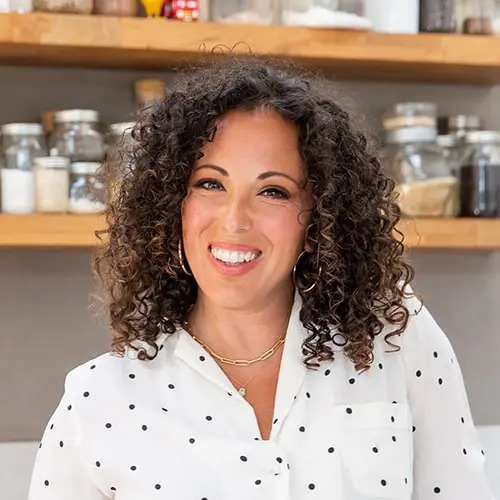In college, I tracked my periods on my wall calendar. A red dot (so subtle!) marked day 1 of my period. It wasn’t very advanced, but it was when I first started paying attention to my not-so-monthly cycle. Back then I also read paperbacks and kept a grocery list on a magnetic notepad on my fridge.
I don’t do any of those things anymore though because – hey, there’s an app for that!
If you’re like me, you keep everything on your phone now, and there are even some amazing fertility tracking apps you can get, too. These apps don’t just help you remember when you last got your period – the best ones can accurately predict when you’ll ovulate each month. You can use that information to help you get (or not get) pregnant.
But not every fertility tracking app you can download is actually useful. Some really can help you predict when you’re ovulating, but others are no more sophisticated than my old red-dot method.
Let me explain how and what fertility trackers can and can’t do – and I’ll tell you which ones I use and recommend (even if you have PCOS or irregular periods!).
Why Should I Track My Cycle?
I recommend cycle tracking for all women. Your period is one of the biggest indicators of your overall health – but it’s also really sensitive to changes. Little changes in your cycle can be a clue of a bigger problem, even before any other symptoms show up.
Plus, being aware of your cycle gives you powerful information about your body. As you get more in tune with your cycle, you may even start basing some other patterns around it (like how you eat or your exercise throughout the month).
And of course, the obvious reason to track your cycle is to track your fertility (by knowing when you ovulate). This is not just for women who are trying to get pregnant – you can use this information to help you get pregnant more easily OR to avoid pregnancy without having to use hormonal birth control methods.
Yes – the right fertility tracking app can replace hormonal birth control if it is used correctly!
But if you’re going to rely on cycle tracking to predict your fertility, it’s critical that you use a reliable app – and they aren’t all created equal.
Calendar-Only Apps Can’t Tell You Enough
Unless you are simply trying to get a better sense of cycle length and variations, regular calendar based apps are useless for fertility detection. These are apps like “Period Tracker” that just ask you to track when your period begins and ends.
These apps base their estimation of your fertility on data from your prior cycles, assuming you have a 28-day cycle and Cycle-Day 14 ovulation. But the truth is that fewer than 10% of women actually do. Your cycle length can also vary from month to month. Because most women don’t have this cycle pattern, these apps cannot accurately tell you when you can and can’t conceive.
Which App Should I Use?
If you really want accurate results (and when it comes to getting pregnant or not, accuracy is key) you need a fertility tracker that does more than just count days.
After testing and trying them all, both myself and with my patients, there are three I recommend – one for people whose goal is avoiding pregnancy, and another two for those who are looking to conceive OR who have very irregular cycles (my PCOS sisters, this one is for you!)
Let me break them all down for you.
If You’re Trying To Avoid Pregnancy (And Or Get Pregnant & Have Regular Cycles)
If you want to track your cycle, get a better understanding of your fertile window and monthly rhythms, and/or avoid pregnancy, I think the Kindara Fertility Tracker is the simplest to use and has a great track record.
Kindara is an app that you use along with a basal thermometer (which gives temperature to the second decimal).All you need to do is remember to take your temperature using the thermometer every morning, right when you wake up, and enter that data into the app. You’ll also track changes in your cervical mucus.
Research by the CDC has shown that, when used perfectly, this method of birth control is 99.6% effective!
Kindara reports days to you as either fertile or not fertile, based on your temperature, past cycles, and cervical mucus. If you’re avoiding pregnancy, abstain or use a non-hormonal birth control method when you’re fertile.
At only $4.99/month (and with a free basic version, as well), the Kindara app is a great alternative to hormonal birth control and is a useful tool for tracking your fertility.
If You’re Trying to Get Pregnant – Or You Have Long or Irregular Cycles
If your goal is to get pregnant, or if you have PCOS or irregular cycles (whether you want to get pregnant or avoid pregnancy) I recommend both Oova and the new Priya.
Priya is a vaginal sensor that monitors temperature all day long. It’s a silicone ring that you can wear continuously for up to 29 days – or remove for up to three hours daily – that takes regular temperature readings.
Because it measures core temperature, and because it takes readings all day long, every 6 minutes, the resulting temperature data is much more accurate than taking a single, oral reading.
Priya is able to predict ovulation up to 2.5 days in advance of a LH surge on an ovulation urine test and data in trials suggests it is just as accurate as an ultrasound, which is the gold standard for ovulation testing!
If you have PCOS, or unexplained fertility, using Priya can unlock a huge piece of the puzzle. The same holds true if you have irregular cycles or irregular ovulation from any cause, and are either trying to conceive, or trying to avoid it. It also works if a woman is taking fertility treatments in the form of herbs or medications to promote ovulation.
And if you’re wondering if it’s safe to wear, I have you covered! My first question was about the potential for EMF exposure. What makes Priya cool is that it only connects to the device once an hour for a few minutes, and it’s at a very low power. You can also change the setting and have it connect even less often, 1-2x daily is all that’s needed, and you can remove it before connecting. It will still read and store your temperature, even when disconnected.
I also asked about the potential for biofilm buildup and vaginal microbiome disruption (which is a major issue with other vaginal rings, like Nuvaring). Priya is different because it’s made from washable silicone. You can take it out every day and wash it, and it can be removed up to 3 hours per day and still be effective.
Priya is not yet available to the public, but I am testing it with my clients and loving the results. Sign up for pre-orders here.
Another Amazing Option – Especially for PCOS!
Along with Priya, I recommend Oova, which uses urine tests (think pee-on-a-stick pregnancy tests) to track fertility throughout the month instead of temperature. You order a kit with 15 tests, and enter test results into the app for lab-quality results.
Honestly, I love Oova. The technology was developed by a doctor who struggled with fertility herself, and it’s unlike anything else you can buy.
You’ve probably heard of LH tests (AKA Ovulation Predictor Kits) before: you can buy them at the drugstore, and until now they were the best option for at-home ovulation prediction. But the big problem is that LH – luteinizing hormone – is present in your urine all month, and it surges just before ovulation. All an LH test can tell you is that ovulation is coming in the 24 hours or so – and that depends on you taking it at the right time (too early or too late and you’ll miss the tell-tale surge). Plus, interpretation can be confusing: is today the strongest pink line? Was it yesterday? Will it be tomorrow?
If you’re trying to get pregnant, LH tests alone aren’t very helpful because your fertile window is actually 5 days up until you ovulate, and an LH test misses most of that. And, an LH surge doesn’t always mean that an egg has actually been released, as some women don’t release an egg every cycle.
Oova uses super-sensitive, nanotechnology LH tests along with progesterone tests to solve this problem. Progesterone levels rise when an egg is released from the follicle in the ovary where it has been growing. High progesterone levels are also necessary for the vascular development of endometrial lining, and to prevent shedding of the endometrial lining if you are pregnant. By tracking progesterone levels with LH, Oova gets a complete look at your cycle.
You’ll use the Oova tests – which are read by the app, so you don’t have to do any interpretation – to establish your hormonal baseline and then see the changes that indicate your fertile window. It can uncover your exact, unique cycle length, and confirm that ovulation has in fact occurred – so it’s ideal for women with irregular cycles or PCOS!
I love to pair Oova with Priya or Kindara data, too – especially for tricky, irregular cycles who are trying to conceive!
Learn more and get Oova here. Use code BWIH1 for 15% off your Oova order!
Can A Fertility Tracker Really Replace Other Forms of Birth Control?
Like I said before, I recommend tracking your cycle to all women – even if it’s just a simple calendar app for right now.
But the right fertility tracking app CAN replace other forms of birth control as long as you’re doing it the right way. Just like with the pill or condoms, user error is the biggest problem with using fertility tracking as a birth control method.
Before you get started, read all the instructions included with your fertility tracking app – and when in doubt, use a backup method like a condom. My favorite condoms are Sustain Natural Latex Condoms, which are nitrosomine-free (nitrosomine is is a carcinogen that is formed when latex is heated and formed). The rubber they use for manufacturing their latex is also non-GMO and fair trade, which is really significant with condoms, as child labor and harsh working conditions are a big issue in many rubber plantations world-wide.
Do You Track Your Fertility?
If you have experience with the Kindara, Priya, or Oova, I’d love to hear how it worked for you! Got another fertility tracking app you love? Leave a comment and let me know.
And if you’re not yet tracking your fertility but want to give it a try using one of the apps I recommend, save 15% on the Oova kit with code BWIH1!
At the Reverse-Age Method, we believe in a holistic approach to perimenopause and beyond, that addresses the root causes of your symptoms (like insomnia, hot flashes, night sweats, erratic periods, fatigue, skin aging, weight gain, and brain fog)– to also slow the pace that your cells are aging. Whether it’s improving gut health, optimizing detox function, enhancing mitochondrial function, or building muscle mass, our comprehensive program has got you covered.
If you’re new here, be sure to check out our Blog Page for more insights and tips on how to thrive during perimenopause. Our blog is packed with practical advice, success stories, and the latest research to help you on your journey.
For more updates and community support, follow us on social media:
You May Also Like...
Natural Treatment of PMS and PMDD
Raise your hand if you struggle with menstrual cramps, painful periods, irritability, mood swings, depression, and more…
The Surprising Truth About Low Stomach Acid (And How To Solve It Naturally)
Do you burp after meals? How about get so bloated, you want to unbutton your pants? Does food feel like it just sits in…
Whether you’re looking for help with your gut, your hormones, or both, our team of practitioners work together to treat the WHOLE you – guiding you to a healthier mind, body, and spirit day by day.



